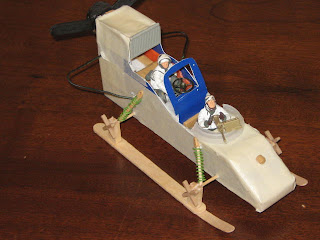
Scale Modelling
One/35 Scale Modelling Dioramas
Welcome to Outoppies Scale Modelling and Dioramas Blog
Friday, January 29, 2010
Wednesday, January 27, 2010
Vietnam Huey Slick Dio

http://www.scale-rotors.com/gallery/utility-helicopters/bell-uh-1d-huey-slick-dragon
Additional items
- Dragon 1/35 Viet Cong 3304
- Dragon Huey Slick
- Dragon 1/35 U.S. 1St Cavalry 3312
- Andrea Miniatures 1/32 S2A2 Ox
- Verlinden 1/35 Vietnamese Civilians 298
Tuesday, January 26, 2010
Salt Weathering
Simulating paint chips and wear with salt
 This close up shows how rust had caused the paint on the side of this AFV to flake away. Paint can also be removed due to regular wear and abrasions.
This close up shows how rust had caused the paint on the side of this AFV to flake away. Paint can also be removed due to regular wear and abrasions.
Introduction
This tutorial will provide a step-by-step guide to a technique that simulates paint chipping and rust effects using common table salt. The method is quick, easy and relatively forgiving.
Background
The pristine appearance of combat vehicles and aircraft when they come out of the factory does not tend to last very long when subjected to the hard realities of life in the field.
Even during times of peace, military equipment gets rough treatment since it will be subject to exercises that simulate combat. As a result, the upper coats of paint will often show the underlying layers due to wear and tear, corrosion, or accidents.

This German fighter plane exhibits unusual paint wear near the nose.Unless you intend to make your models as they appeared when brand new, then you will have to face the problem of simulating wear, damage and dirt - generally known as 'weathering'.
Friday, January 22, 2010
Wednesday, January 20, 2010
Incredible 1918 Picture

This INCREDIBLE picture was taken in 1918.
It is 18,000 men preparing for war in a training camp at Camp Dodge , in Iowa .
EIGHTEEN THOUSAND MEN!!!!!
FACTS:
Base to Shoulder: 150 feet
Right Arm: 340 feet
Widest part of arm holding torch: 12 1/2 f eet
Right thumb: 35 feet
Thickest part of body: 29 feet
Left hand length: 30 feet
Face: 60 feet
Nose: 21 feet
Longest spike of head piece: 70 feet
Torch and flame combined: 980 feet
Number of men in flame of torch: 12,000
Number of men in torch: 2,800
Number of men in right arm: 1,200
Number of men in body, head and balance of figure only: 2,000
Total men: 18,000
Sunday, January 10, 2010
WW2 Ski Sleds Aerosan



aerosan
An aerosan (Russian: aэросани, aerosani, literally 'aerosled') is a type of propeller-powered snowmobile, running on skis, used for communications, mail deliveries, medical aid, emergency recovery and border patrolling in northern Russia, as well as for recreation. Aerosans were used by the Soviet Red Army during the Winter War and the Second World War.
The first aerosans may have been built by young Igor Sikorsky in 1909–10, before he built multi-engine airplanes and helicopters. They were very light plywood vehicles on skis, propelled by old airplane engines and propellers.
Military aerosans
Military use of the aerosan goes back to at least the 1920s. During the 1939–40 Winter War against
During WWII, aerosans were found to be useful for reconnaissance and light raiding in northern areas, thanks to their high mobility in deep snow (25–35 km/h, where many vehicles couldn't move at all). Responsibility for aerosans was transferred to the Soviet Armoured Forces (GABTU) and orders were submitted for design and fabrication of lightly-armoured versions, protected by ten millimetres of steel plate on front.
http://www.armor.kiev.ua/Tanks/WWII/sani/
http://wapedia.mobi/en/Aerosan
http://www.armor.kiev.ua/Tanks/WWII/sani/?img=sani4.jpg.html
www.wikipedea.com
I tried my own scratchbuild version for the Germans:











